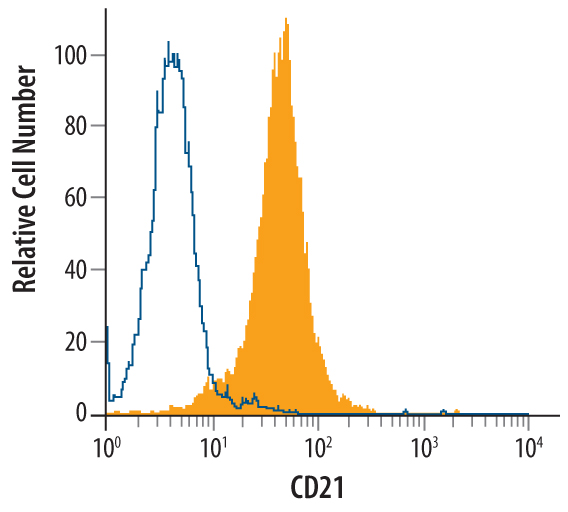Human CD21 Antibody Summary
Ile21-Arg971
Accession # P20023
Applications
Please Note: Optimal dilutions should be determined by each laboratory for each application. General Protocols are available in the Technical Information section on our website.
Scientific Data
 View Larger
View Larger
Detection of CD21 in Daudi Human Cell Line by Flow Cytometry. Daudi human Burkitt's lymphoma cell line was stained with Sheep Anti-Human CD21 Antigen Affinity-purified Polyclonal Antibody (Catalog # AF4909, filled histogram) or control antibody (5-001-A, open histogram), followed by NorthernLights™ 557-conjugated Anti-Sheep IgG Secondary Antibody (NL010).
 View Larger
View Larger
Detection of CD21 in Human Tonsil. CD21 was detected in immersion fixed paraffin-embedded sections of Human Tonsil using Sheep Anti-Human CD21 Antigen Affinity-purified Polyclonal Antibody (Catalog # AF4909) at 3 µg/mL for 1 hour at room temperature followed by incubation with the Anti-Sheep IgG VisUCyte™ HRP Polymer Antibody (Catalog # VC006). Before incubation with the primary antibody, tissue was subjected to heat-induced epitope retrieval using VisUCyte Antigen Retrieval Reagent-Basic (Catalog # VCTS021). Tissue was stained using DAB (brown) and counterstained with hematoxylin (blue). Specific staining was localized to lymphocytes in germinal center. View our protocol for IHC Staining with VisUCyte HRP Polymer Detection Reagents.
Reconstitution Calculator
Preparation and Storage
- 12 months from date of receipt, -20 to -70 °C as supplied.
- 1 month, 2 to 8 °C under sterile conditions after reconstitution.
- 6 months, -20 to -70 °C under sterile conditions after reconstitution.
Background: CD21
CD21, also known as complement receptor 2 (CR2), is a 145 kDa N-glycosylated member of the RCA (regulators of complement activation) family of proteins. The complement cascade plays an important role in the innate immune system through the recognition and clearance of immune complexes and foreign particles (1). Mature human CD21 contains a 951 aa extracellular domain (ECD) with fifteen tandem SCR/SUSHI repeats, a 28 aa transmembrane segment, and a 34 aa cytoplasmic tail (2, 3). Within the ECD human CD21 shares 67% aa identity with mouse and rat CD21. Human CD21 and CD35 are encoded by two separate genes, but in mouse partially homologous proteins are alternate splice forms of one gene (4). Alternate splicing of human CD21 generates isoforms with an altered SCR8 or an insertion between SCR10 and SCR11 (5). CD21 is primarily expressed on B cells, follicular dendritic cells, and T cells. A circulating soluble form of CD21 is released by proteolytic shedding from activated B cells (6, 7). CD21 binds the complement component fragments iC3b, C3d, and C3d,g (1, 8). It forms a complex with the B cell receptor-associated CD19 molecule and lowers the threshold for B cell activation (9‑11). CD21 can also form complexes with the complement receptor CD35/CR1 (1, 10). Mice deficient in both CD21 and CD35 exhibit normal B cell development but severely compromised germinal center development, antibody production, establishment of protective microbial immunity, and B cell tolerance to self antigens (12, 13). In mice, CD21/CD35 must additionally be present on follicular dendritic cells to mount effective humoral responses and establishment of B cell memory (14). CD21 also binds the gp350 coat protein on Epstein-Barr virus and serves as an uptake receptor for viral infection of B cells (15).
- Roozendaal, R. and M.C. Carroll (2007) Immunol. Rev. 219:157.
- Weis, J.J. et al. (1988) J. Exp. Med. 167:1047.
- Moore, M.D. et al. (1987) Proc. Natl. Acad. Sci. 84:9194.
- Kurtz, C.B. et al. (1990) J. Immunol. 144:3581.
- Barel, M. et al. (1998) Mol. Immunol. 35:1025.
- Masilamani, M. et al. (2003) Eur. J. Immunol. 33:2391.
- Sengstake, S. et al. (2006) Int. Immunol. 18:1171.
- Carel, J.-C. et al. (1990) J. Biol. Chem. 265:12293.
- Matsumoto, A.K. et al. (1991) J. Exp. Med. 173:55.
- Tuveson, D.A. et al. (1991) J. Exp. Med. 173:1083.
- Dempsey, P.W. et al. (1996) Science 271:348.
- Haas, K.M. et al. (2002) Immunity 17:713.
- Prodeus, A.P. et al. (1998) Immunity 9:721.
- Rossbacher, J. et al. (2006) Eur. J. Immunol. 36:2384.
- Tanner, J. et al. (1987) Cell 50:203.
Product Datasheets
FAQs
No product specific FAQs exist for this product, however you may
View all Antibody FAQsReviews for Human CD21 Antibody
There are currently no reviews for this product. Be the first to review Human CD21 Antibody and earn rewards!
Have you used Human CD21 Antibody?
Submit a review and receive an Amazon gift card.
$25/€18/£15/$25CAN/¥75 Yuan/¥2500 Yen for a review with an image
$10/€7/£6/$10 CAD/¥70 Yuan/¥1110 Yen for a review without an image

